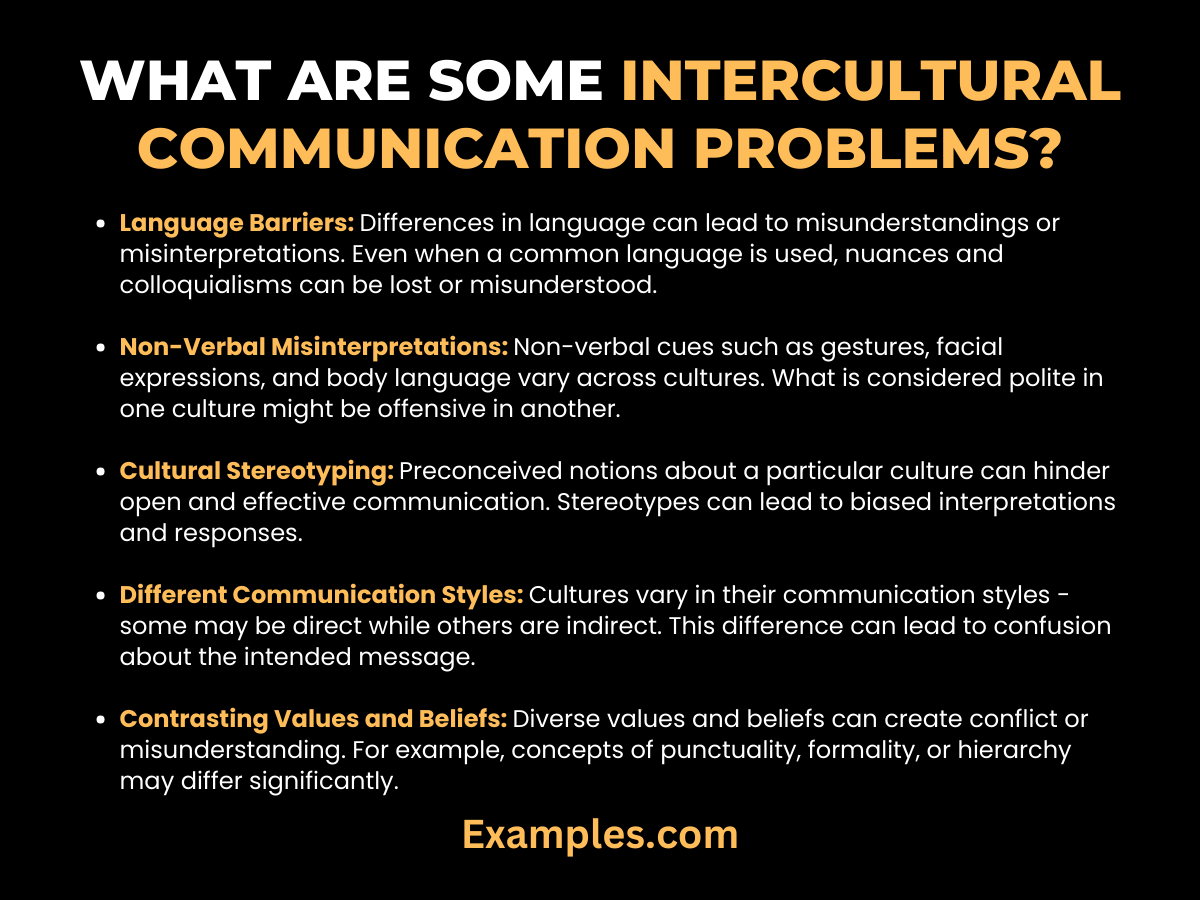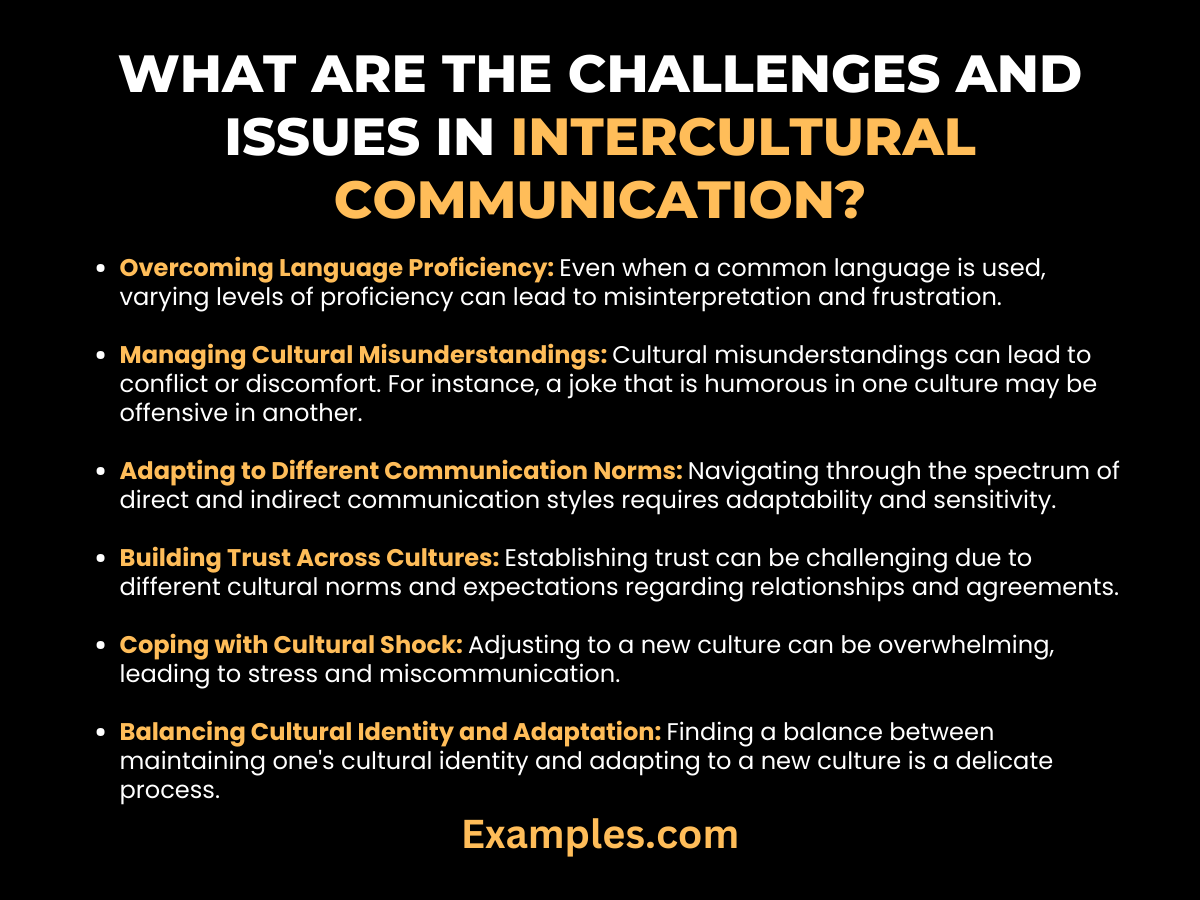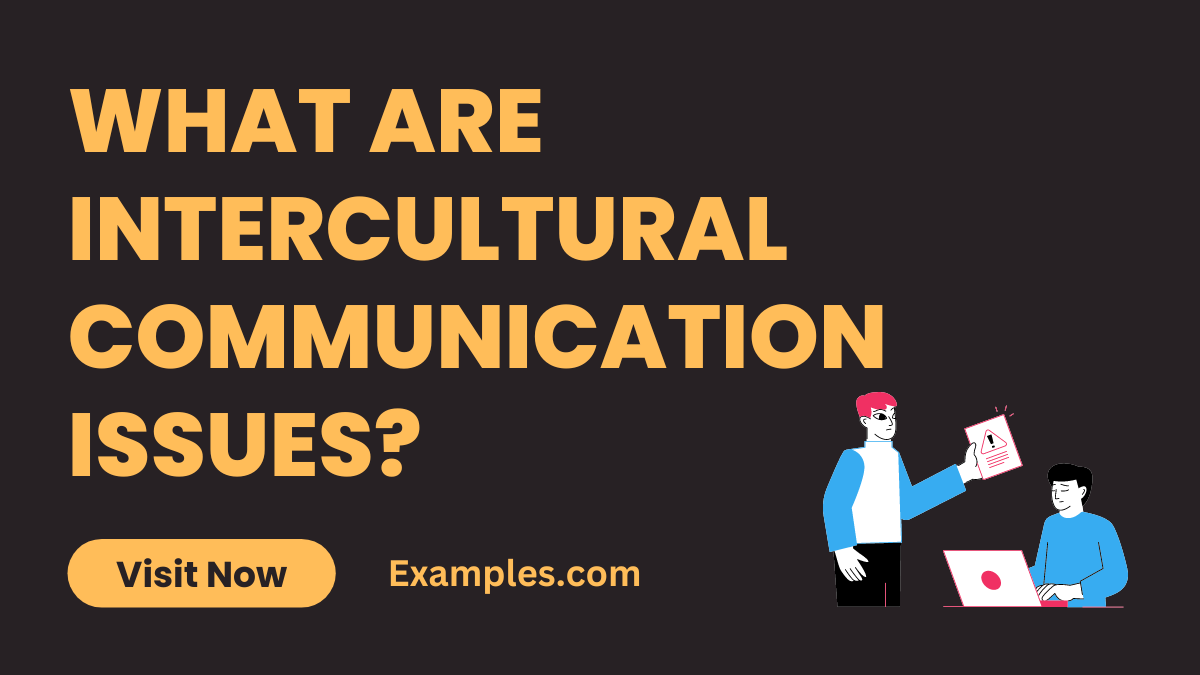What are Intercultural Communication Issues?
Exploring Intercultural Communication Issues is crucial in our globally connected world. This guide delves into various challenges encountered when individuals from different cultural backgrounds interact. With practical Intercultural Communication Examples, it offers insights into common misunderstandings, cultural nuances, and effective strategies to overcome these barriers. Whether in business, education, or social contexts, understanding these issues is key to fostering respectful and productive communication across diverse cultures, enhancing both personal and professional relationships.
What are Intercultural Communication Issues?

Intercultural Communication Issues are problems or misunderstandings that happen when people from different cultural backgrounds try to communicate. These issues often arise due to differences in language, cultural norms, beliefs, and communication styles. They can lead to confusion, misinterpretation, and sometimes conflict. Understanding and addressing these issues is important for effective communication in our increasingly diverse world.
What are some Intercultural Communication Problems?
Intercultural Communication Problems often arise from the inherent differences in cultural backgrounds of the communicators. These problems can significantly impact the effectiveness of communication in diverse settings. Here are some common issues faced in Intercultural Communication:

- Language Barriers: Differences in language can lead to misunderstandings or misinterpretations. Even when a common language is used, nuances and colloquialisms can be lost or misunderstood.
- Non-Verbal Misinterpretations: Non-verbal cues such as gestures, facial expressions, and body language vary across cultures. What is considered polite in one culture might be offensive in another.
- Cultural Stereotyping: Preconceived notions about a particular culture can hinder open and effective communication. Stereotypes can lead to biased interpretations and responses.
- Different Communication Styles: Cultures vary in their communication styles – some may be direct while others are indirect. This difference can lead to confusion about the intended message.
- Contrasting Values and Beliefs: Diverse values and beliefs can create conflict or misunderstanding. For example, concepts of punctuality, formality, or hierarchy may differ significantly.
- High Context vs. Low Context Communication: High-context cultures rely heavily on implicit communication and shared understanding, while low-context cultures depend on explicit verbal communication. This difference can cause miscommunication.
- Ethnocentrism: The belief that one’s own culture is superior can lead to a lack of respect for other cultures, impeding effective intercultural interactions.
- Conflicting Norms and Etiquette: Different norms and etiquette rules can lead to awkward or offensive situations, such as differing views on personal space or eye contact.
- Assumptions of Similarity: Assuming that others perceive and interpret the world in the same way can lead to misunderstandings.
- Technological Challenges: In our digital world, reliance on electronic communication can exacerbate intercultural misunderstandings due to the lack of face-to-face cues and immediate feedback.
What are the Communication Issues in Intercultural Settings?
Communication in intercultural settings is fraught with specific issues that can hinder the flow of information and understanding. Recognizing these issues is the first step toward mitigating their impact. Here are some key communication issues commonly encountered in intercultural settings:
- Language Proficiency Gaps: Differences in language fluency can lead to misunderstandings or misinterpretations of the intended message.
- Cultural Misconceptions: Misconceptions about another culture can lead to incorrect assumptions and inappropriate responses in communication.
- Differing Contextual Interpretations: The same message can be interpreted differently based on cultural backgrounds, leading to confusion or conflict.
- Varying Non-Verbal Communication Codes: Non-verbal signals such as gestures, facial expressions, and body language differ across cultures and can be misinterpreted.
- Contrasting Communication Styles: The preference for direct versus indirect communication varies by culture, which can lead to misunderstandings or perceived rudeness.
- Diverse Attitudes Toward Hierarchies and Authority: Different cultures have different views on hierarchy and authority, which can affect communication dynamics, especially in group settings.
- Assumptions About Common Knowledge: Assuming shared understanding or common knowledge can lead to gaps in communication.
- Technological Barriers: In today’s digital world, reliance on technology for communication can amplify misunderstandings due to the absence of face-to-face cues.
- Time Orientation Differences: Different cultures perceive and manage time differently, which can affect scheduling, deadlines, and pacing in communication.
- Impact of Stereotypes and Prejudices: Existing stereotypes and prejudices can color the interpretation of messages, leading to biased communication.
What are the Challenges and Issues in Intercultural Communication?
The challenges and issues in Intercultural Communication are diverse and multifaceted, affecting both personal and professional interactions. These challenges can hinder effective communication and collaboration in various contexts:

- Overcoming Language Proficiency: Even when a common language is used, varying levels of proficiency can lead to misinterpretation and frustration.
- Managing Cultural Misunderstandings: Cultural misunderstandings can lead to conflict or discomfort. For instance, a joke that is humorous in one culture may be offensive in another.
- Adapting to Different Communication Norms: Navigating through the spectrum of direct and indirect communication styles requires adaptability and sensitivity.
- Building Trust Across Cultures: Establishing trust can be challenging due to different cultural norms and expectations regarding relationships and agreements.
- Coping with Cultural Shock: Adjusting to a new culture can be overwhelming, leading to stress and miscommunication.
- Balancing Cultural Identity and Adaptation: Finding a balance between maintaining one’s cultural identity and adapting to a new culture is a delicate process.
- Dealing with Prejudices and Discrimination: Prejudices and discrimination can create barriers to open and effective communication.
- Addressing Power Dynamics: Power dynamics, influenced by cultural backgrounds, can impact communication in diverse groups or teams.
- Ensuring Inclusivity: Creating an inclusive environment where all cultural perspectives are respected and valued is a continual challenge.
- Evaluating Communication Effectiveness: Assessing whether the intended message was understood as intended is difficult in intercultural contexts.
What are the Major Issues of Intercultural Communication Conflict?
Intercultural communication conflicts arise from deep-rooted cultural differences and misunderstandings. Identifying these issues is essential to manage and resolve conflicts effectively. Here are the major issues that often lead to intercultural communication conflict:
- Cultural Value Misalignments: Conflicts often stem from differing core values and beliefs inherent in each culture, such as individualism versus collectivism.
- Language Misinterpretations: Misunderstandings or misinterpretations due to language differences can escalate into conflicts.
- Differing Conflict Resolution Styles: Cultures have different ways of handling conflicts, from direct confrontation to avoidance, which can lead to misunderstandings in how conflicts are approached and resolved.
- Perceptions of Politeness and Respect: What is considered polite or respectful in one culture might be seen as the opposite in another, leading to unintentional offense.
- Expectations of Formality and Informality: Misaligned expectations about formality can lead to discomfort and conflict, especially in professional settings.
- Contrasting Approaches to Time Management: Differing attitudes towards punctuality and time management can lead to frustration and conflict.
- Non-Verbal Miscommunication: Misreading non-verbal cues due to cultural differences can lead to incorrect interpretations and escalate tensions.
- Power Dynamics and Inequality: Imbalances in power dynamics influenced by cultural background can lead to conflict, especially in hierarchical settings.
- Resistance to Cultural Adaptation: A lack of willingness to adapt or understand another culture can lead to rigidity and conflict.
- Ethnocentrism and Cultural Superiority: Believing that one’s own culture is superior can lead to disrespect and conflict in intercultural interactions.



